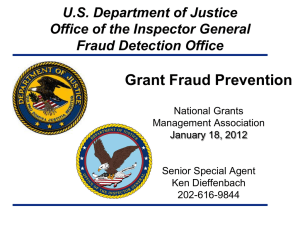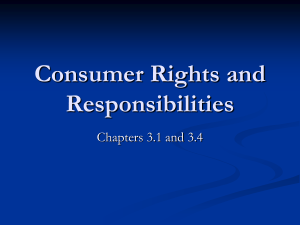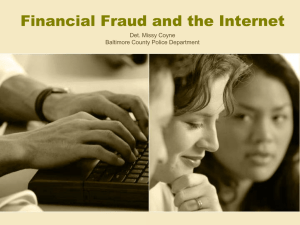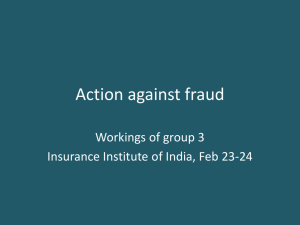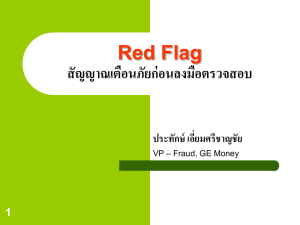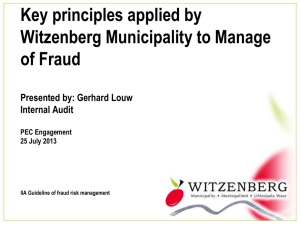2 Fraud- Prevention, Detection a
advertisement
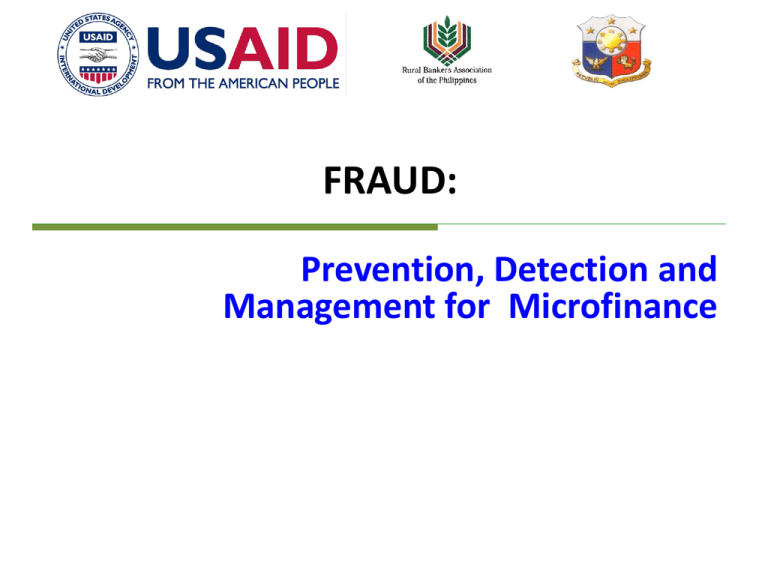
FRAUD: Prevention, Detection and Management for Microfinance • DEFINED – A deception deliberately practiced in order to secure unfair or unlawful gain or causing loss to another party • Fraud may originate from employees of the bank and/or clients. • Fraud can happen in all stages of the loan process – loan solicitation, collection, account monitoring, and delinquency management. Workshop 1: Types of Fraud per Loan Stage Objectives of the Workshop • To draw from participants encountered fraudulent activities that happened in their institutions. • Understand how this fraudulent activities happened. Workshop Guide • This workshop is a contest. • Form the participants into 3 groups • Each group will be given metacards to list down as many fraudulent activities encountered in their institutions ( 1 metacard, 1 idea). 10 minutes • Each metacard will be classified under the columns: loan solicitation, collection, monitoring, delinquency management and others. • The group who identified the most type of fraud, which the other groups were not able to identify, gets a prize. DIFFERENT FACES OF FRAUD Bribe Commissions “Processing Fee” “Ride-on” Loans Over-appraised collateral Ghost accounts Dummy accounts False identification Recycled Borrower Possible Perpetrators Fraud Type Other AO Supervisor Bank Staff Others Borrower Center Officers Accepting Bribes Commissions “Processing Fee” “Ride-on” Loans Over-appraised collateral Dummy Accounts Ghost Accounts False identification Possible Perpetrators Fraud Type Recycled Borrower Borrower Center Officers Other AO Supervisor Bank Staff Others Non-remittance of collection Non-issuance of OR Altering OR details Fake OR Lapping Cashing-out cheques “Hold-up” Altering MIS record OR 1 OR 25 Possible Perpetrators Fraud Type Borrower Center Officers Other AO Supervisor Bank Staff Others Non-remittance of collection Non-issuance of OR Altering OR details Fake OR Lapping Cashing-out cheques “Hold-up” Altering MIS records Intentional Misposting Unauthorized withdrawal Possible Perpetrators Fraud Type Borrower Center Officers Other AO Supervisor Bank Staff Others Intentional Misposting Unauthorized withdrawal Penalty? Non-remittance of penalty fees Unauthorized restructuring or extension “Foreclosure” scam Writing-off recoverable accounts Possible Perpetrators Fraud Type Borrower Center Officers Other AO Supervisor Bank Staff Others Non-remittance of penalty fees Unauthorized restructuring or extension “Foreclosure scams” Writing-off recoverable accounts Overclaiming/ False claim of expense Stealing discounts “Private business” False benefit claims Financial reports manipulation Possible Perpetrators Fraud Type Borrower Center Officers Other AO Supervisor Bank Staff Others Overclaiming/ False claim of expenses Stealing discounts “Private Business” False benefit claims Financial reports manipulation Workshop 2: List in Manila Paper practices and policies on how your bank prevent fraud HANDLING FRAUD “While fraud cannot be totally eliminated, it can be prevented and controlled.” • Essential components why fraud occurs – Motive – Pressure – Opportunity 1. Internal control systems are loose 2. Policies are not being followed 3. Managers and owners run the business on the basis of “trust” rather than “sound internal controls” • The benefits of prevention outweigh the costs. • “Ultimately, reducing the risk of fraud is a matter of good management, of creating a work environment that reduces the incentives for employees to commit fraud.” Richard Hook Microenterprise Development Brief, June 1995. • Tips: – Minimize motivation to commit fraud: Institutionalize a culture of professionalism, to include honesty and compliance – Close the window of opportunity to commit fraud: Evaluate your bank’s Internal Control System effectiveness, its policies and implementation, based on identified risk areas. - SMS notifications to clients: Notifying clients of all payments, deposits, & withdrawals made each day via SMS can reduce unauthorized or unremitted transactions. • Best practices to prevent fraud: – Policies and procedures are written, simple/clear, available, understood, relevant, and implemented • i.e Loan/Savings product and procedures manual, Restructuring manual, HR Management manual – Segregation of duties and instituting check & balances within functions • Are the functions of receiving and processing loan payment and of bookkeeping performed by different employees? • Are the functions of issuing, recording and signing of checks covering release of loan proceeds handled by different employees? • Are credit monitoring reports obtained by an employee other than the lending officer? • Best practices to prevent fraud: – Safeguarding of assets, documents, and controlled forms – Continuous test of effectiveness of preventive controls and procedures in place • Organizational structure • Roles of internal auditors, • Internal audit manual – Close monitoring and visibility of bank officers • Best practices to prevent fraud: – Efficient Management Information System and systematic record-keeping – Effective human resource system/ administration • Hire and attract honest well-suited staff • Do background check of applicants • Properly orient and train on culture of honesty and zero tolerance. Values are caught, not taught. • Provide reasonable and competitive staff remuneration • Do employee lifestyle check • Have policies for fraud and dishonesty • Best practices to prevent fraud: – Personnel rotation – Properly informed clients. With feedback handling system Workshop 3: Create an advertisement ( poster statement) to encourage client feedback • Main ways in which fraud may be uncovered: 1. Discoveries by management, usually emerge from careful monitoring and internal controls; 2. Routine or specific audit checks of policies & systems; – Types of audit: regular, special, and spot 3. Operations review; 4. “Whistle-blower” or tip from a concerned individual – either internal or external party (clients) 5. By accident • Learn to “think like a thief to catch a thief” • Tips: – – – – – – – – Check proper implementation of management controls Do documentation checks Do trend analysis Review properly-generated MIS reports Have competent, courageous, and efficient auditors Do regular operations review – preferably not from the operations team Do field validation visits Set-up customer hotlines Workshop 4: List the DO’s and DON’Ts in account validation Workshop 5: List and compare columns that can be found in your MIS-generated reports (performance report per AO, PAR Aging report, Delinquency Report and Listing of Loans). Analyze the accuracy and consistency of item value/amount/number across reports. • Managing the Investigation: – – – – – – Consider how to minimize any further loss; Ensure that adequate resources are provided to carry out the investigation; Subject to appropriate disciplinary procedures from the Human Resource directorate; Identify and preserve all original documents and other exhibits relating to the intended complaint Submit timely reports to management, third-party stakeholders, and regulators Define the timeline from report submission to implementation of sanctions • Recovery of Loss: – – Quantify any loss and account for affected loans/deposits Seek recovery of losses from: 1. 2. 3. Bonds – fidelity, property, cash Personal assets Legal action • Public Relations: – Coordinate any public relations work – Decide and manage information dissemination – send a clear and firm message that fraud is taken seriously and will not be tolerated FRAUD: Can be prevented, detected and managed Maraming Salamat po!

